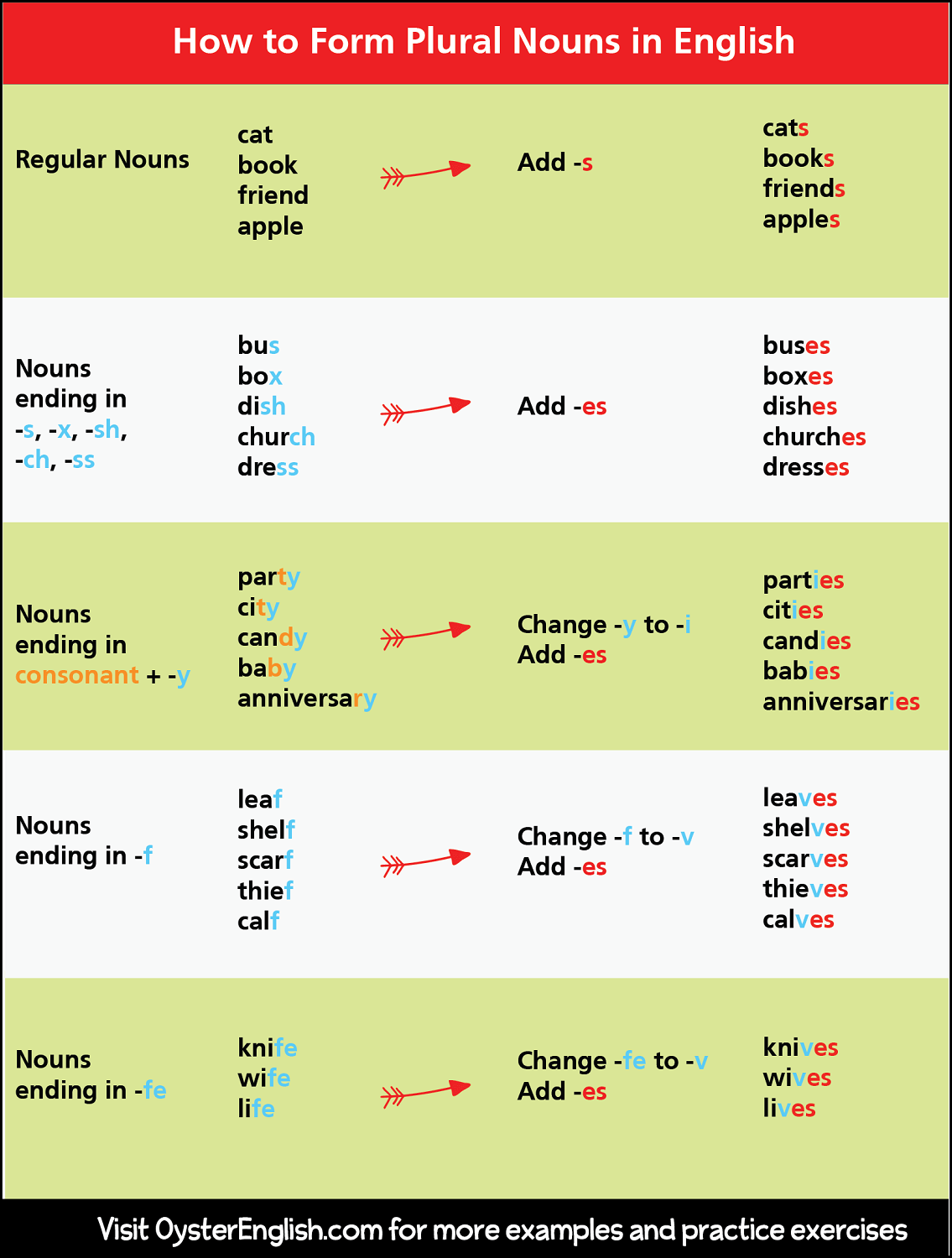(Taken from https://www.oysterenglish.com/plural-nouns.html)
Let's look at the basics for forming and spelling plural nouns, which can be tricky.
There are many exceptions, however there are several tips and tricks that will really help you.
Before we get started, let's quickly review both singular and plural nouns:
Singular nouns name one (single) person, place, thing, animal or idea.
- Examples: apple, culture, finger, cat, bed
Plural nouns name more than one person, place thing, animal or idea.
- Examples: apples, cultures, fingers, cats, beds
(By the way, for an overview of all the different types of nouns, click here).
Regular Plural Nouns
Normally, the plural of a noun is formed by adding -s:
Singular ( = 1) dog a month one plant my face this cake | Plural ( >1) dogs three months several plants their faces these cakes |
Other Ways to Form Plural Nouns
Although we add -s to change most singular nouns to plural nouns, there are many nouns that have a different ending in the plural.
I know what your thinking...aaarrghh!
The reason many of these have spelling changes is to make them easier to pronounce.
For example, if the plural of "bus" were "buss" it would either sound strange or we'd have the same sound. "Buses" is much easier to pronounce.
Luckily, there are a few simple tips and tricks (otherwise known as rules) that will help you:
Rule 1: Add -es Ending for words ending with -s, -x, -sh, -ch, -ss
Look at the end of the word and if it ends in the letters above, you add an -es.
For example:
- words ending in -s: gas — gases, bus — buses, lens — lenses
- words ending in -x: box — boxes, reflex — reflexes, hoax — hoaxes, tax — taxes
- words ending in -sh: brush — brushes , wish — wishes, clash — clashes
- words ending in -ch: lunch — lunches , watch — watches, punch — punches
- words ending in -ss: boss — bosses , kiss — kisses, business — businesses
Rule 2: Change -y to -i and add -es
If a noun ends with a consonant plus a -y, then change the -y to an -i and add -es.
* Did you remember there are 21 consonant letters in the English written alphabet: b, c, d, f, g, h, j, k, l, m, n, p, q, r, s, t, v, w, x, y, z.]
For example:
- blueberry — blueberries [to be clear: blueberry ends with an 'r' (a consonant) and a 'y']
- party — parties
- lady — ladies
- candy — candies
* Be sure to understand that you need a consonant plus a -y at the end of the word. You need both otherwise if the word ends in just a -y it will be regular. [e.g., boy — boys (not boies)]
Rule 3: Change nouns ending in -f or -fe to -ves
If a noun ends with either -f or -fe, change these letters to a -v and add -es.
Examples:
- elf — elves
- self — selves
- knife — knives
- loaf — loaves
- wolf — wolves
*Note: Unfortunately, there are a few exceptions to this rule. Sorry, you'll have to memorize them (see some examples below under irregular plural nouns).
Example: roof — roofs (not rooves)
The chart below can help you remember these few rules.
Irregular Plural Nouns
Unfortunately, some nouns just don't follow any of the rules above when changing from singular to plural.
I know, bummer.
You'll have to memorize these or consult your good friend, Miss Dictionary, if you're unsure.
Nouns ending in -f that don't change to the -ves ending
For example:
Singular belief chief brief cliff cuff roof proof puff | Plural beliefs chiefs briefs cliffs cuffs roofs proofs puffs |
Nouns that are the same in both singular and plural
Singular | Plural |
deer sheep moose series scissors bison | deer sheep moose series scissors bison |

